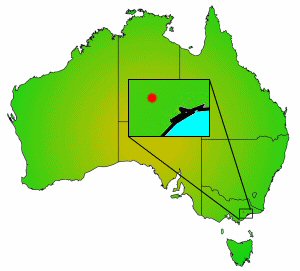Shaw galaxias facts for kids
Quick facts for kids Shaw galaxias |
|
|---|---|
| Conservation status | |
|
Critically Endangered (ASFB)
|
|
| Scientific classification | |
| Genus: |
Galaxias
|
| Species: |
gunaikurnai
|
The Shaw galaxias (scientific name: Galaxias gunaikurnai) is a small freshwater fish. It belongs to a group of fish called galaxiids. This fish is part of the Galaxias family and is found in Australia. It is also a member of the Mountain Galaxias group, which includes several similar types of fish.
Contents
About the Shaw Galaxias
The Shaw galaxias looks a lot like other Galaxias fish. It has a strong, somewhat long body that is shaped like a tube. Its fins are a bit fleshy, especially the ones in the middle of its body.
This fish usually grows to be about 6.5 to 7 centimeters (2.5 to 2.7 inches) long. The biggest one ever found was about 10.4 centimeters (4 inches) long. The top of its head is often flat or even a little bit hollow between its eyes. Its cheeks bulge out below its eyes, and it has a long snout.
The fins on its back (dorsal fin) and belly (anal fin) are fairly long. They are usually about the same size. All its fins are generally rounded. The fins on its belly (pelvic fins) are in the middle of its body. Its front fins (pectoral fins) are shaped like paddles and sit low on its body. The tail fin is quite short.
What Does It Look Like?
The Shaw galaxias is mostly grey-brown or grey-tan on its back and sides. Its head and snout also share these colors. Its belly is usually creamy brown, cream, or white.
Dark grey shading covers the top of its body and head, as well as its upper sides. It also has dark, almost black, blotches and stripes. The gill covers, which protect its gills, are see-through and have a golden patch. Its eyes have a coppery gold color, and its fins are also see-through.
Where It Lives
Right now, the Shaw galaxias is only known to live in one place. This place is Shaw Creek, which is in the Macalister River area of Gippsland in Victoria. The area where it lives is quite small, only about 8 square kilometers (3 square miles).
However, old records show that this fish used to live in more places in this river system. In the 1960s, it was found at least 12 kilometers (7.5 miles) further downstream.
Sadly, the introduction of Brown trout has caused problems. By 2002, the trout had pushed the galaxias to live only above a small barrier in the stream. By 2012, the trout had moved even further upstream. This has forced the Shaw galaxias into a very small side stream.
Its Home Environment
In 2002, this fish was found in a small stream. This stream was about 0.6 to 1.4 meters (2 to 4.5 feet) wide and 15 to 20 centimeters (6 to 8 inches) deep. It had areas of deeper pools, smooth glides, and rocky riffles.
The bottom of the stream was made of bedrock, large rocks, and smaller stones. There were also smaller areas of pebbles, coarse gravel, and sand. The stream is only shaded by its banks and the grass nearby. In winter, the area is usually covered in snow.
Life Cycle and Reproduction
We don't know exactly when the Shaw galaxias lays its eggs. However, scientists think it might be from winter to early spring. This is because they found adult fish ready to lay eggs in May. They also found very young fish, likely born that year, in April and May. These young fish were about 3.2 centimeters (1.2 inches) long.
This fish can handle very cold water. It can survive in water that is less than 5 degrees Celsius (41 degrees Fahrenheit) during winter. Unlike many other Galaxias fish, this species does not travel to the sea or to brackish water (a mix of fresh and salt water). It stays in freshwater for its entire life. The Shaw galaxias is the only native fish found in its current small habitat.
Protecting the Shaw Galaxias
The Shaw galaxias is considered critically endangered. This means it is at a very high risk of disappearing forever. It is protected under a law in Victoria called the Flora and Fauna Guarantee Act 1988.
Not for Fishing
Because the Shaw galaxias is small and critically endangered, people do not fish for it.


